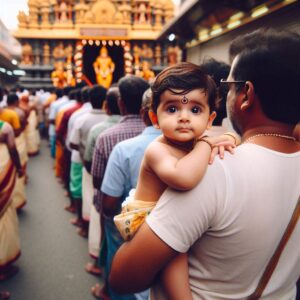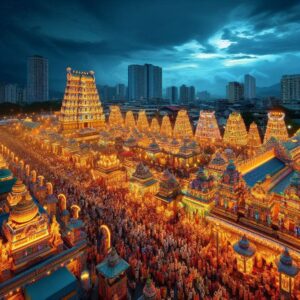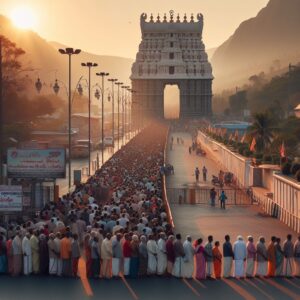
The Sacred Town of Tirupati and Its Rise to Prominence
Nestled in the Chittoor district of Andhra Pradesh, the small town of Tirupati has emerged as one of India’s most revered and visited pilgrimage sites. The town’s fame and significance are inextricably linked to the sacred Sri Venkateswara Temple, an architectural marvel dedicated to Lord Venkateswara, an avatar of Lord Vishnu. This ancient temple has drawn devotees from across the country and beyond for centuries, cementing Tirupati’s place as a spiritual epicenter of South India.
The Origins of the Sri Venkateswara Temple
The history of the Sri Venkateswara Temple can be traced back to the 9th century CE, when it is believed to have been constructed by the Pallava kings. However, the temple’s origins are shrouded in myth and legend. According to Hindu mythology, Lord Venkateswara, an incarnation of Lord Vishnu, descended upon the seven hills of Tirumala to protect and bless his devotees.
The temple’s prestige and popularity grew steadily over the centuries, drawing the attention and patronage of various ruling dynasties, including the Cholas, the Vijayanagar Empire, and the Nayaks of Madurai. Each dynasty left its architectural imprint on the temple complex, contributing to its grandeur and opulence.
The Influence of the Vijayanagar Empire
The Vijayanagar Empire, which ruled a significant portion of South India from the 14th to the 17th century, played a pivotal role in elevating the status of the Sri Venkateswara Temple and the town of Tirupati. The empire’s rulers were ardent devotees of Lord Venkateswara and showered the temple with generous endowments, including land grants and valuable jewels.
One of the most significant contributions came from Krishnadevaraya, the celebrated emperor of the Vijayanagar Empire. Krishnadevaraya commissioned the construction of the magnificent Bangaru Vakili (Golden Bazaar) within the temple complex, a sprawling market where devotees could purchase offerings and souvenirs. This addition not only enhanced the temple’s grandeur but also provided a boost to the local economy, attracting merchants and pilgrims from far and wide.
The Growth of Pilgrimage and Religious Tourism
As the fame of the Sri Venkateswara Temple spread, so did the influx of pilgrims. Tirupati gradually transformed into a bustling religious hub, with a thriving economy centered around the temple and its associated rituals and services.
The temple’s administrators, known as the Tirumala Tirupati Devasthanams (TTD), played a crucial role in facilitating and managing the ever-increasing flow of pilgrims. They established accommodation facilities, guest houses, and other amenities to cater to the needs of the devotees. The TTD also spearheaded the development of infrastructure, such as roads, public transportation, and other essential services, to ensure a seamless pilgrimage experience.
The Influence of Modern Transportation
The advent of modern transportation modes, particularly the railways, further contributed to Tirupati’s rise as a major pilgrimage destination. In 1892, the first rail line connecting Tirupati to the nearby city of Chennai was established, making it easier for devotees from various parts of the country to undertake the journey.
As the railway network expanded and air travel became more accessible, Tirupati witnessed an unprecedented surge in pilgrim footfall. The TTD recognized the need for efficient crowd management and implemented innovative measures, such as online booking systems for darshan (holy viewing) and streamlined queuing processes, to ensure a smooth and organized experience for devotees.
The Role of Religious Festivals and Cultural Events
Tirupati’s prominence as a pilgrimage site is also bolstered by the various religious festivals and cultural events celebrated throughout the year. The most significant of these is the annual Brahmotsavam, a nine-day festival that attracts millions of devotees from across the globe.
During the Brahmotsavam, the temple and its surroundings come alive with vibrant cultural programs, including classical dance performances, music concerts, and elaborate rituals. These festivities not only cater to the spiritual needs of the devotees but also showcase the rich cultural heritage of the region, further enhancing Tirupati’s appeal as a pilgrimage destination.
Economic and Social Impact
The steady influx of pilgrims to Tirupati has had a profound impact on the local economy and social fabric. The town has emerged as a hub for various industries, including hospitality, transportation, and handicrafts, providing employment opportunities for thousands of residents.
Moreover, the temple’s extensive charitable activities, supported by the revenue generated from pilgrim offerings and donations, have played a crucial role in uplifting the local community. The TTD has undertaken numerous initiatives in areas such as education, healthcare, and infrastructure development, contributing to the overall well-being of the region.
Conclusion
Tirupati’s journey from a small temple town to one of India’s most prominent pilgrimage destinations is a testament to the enduring spiritual and cultural significance of the Sri Venkateswara Temple. The town’s rise has been fueled by a combination of factors, including the devotion and patronage of ruling dynasties, the growth of religious tourism, modern transportation advancements, and the celebration of vibrant festivals and cultural events.
Today, Tirupati stands as a symbol of India’s rich spiritual heritage, drawing devotees from all walks of life and corners of the world. As the town continues to evolve and adapt to the changing times, its sacred heart – the Sri Venkateswara Temple – remains a constant, offering solace, inspiration, and blessings to all who seek its divine embrace.






